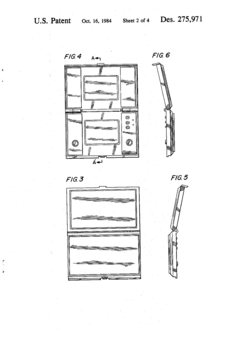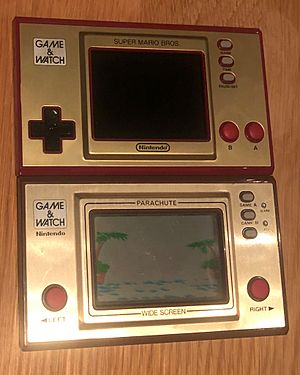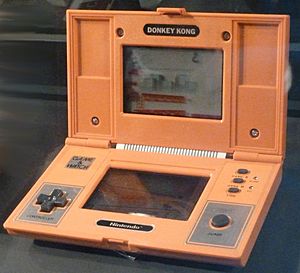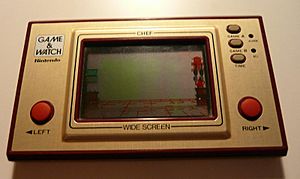- This page was last modified on 17 October 2025, at 10:18. Suggest an edit.
Game & Watch facts for kids
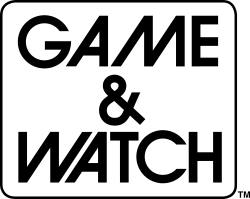 |
|
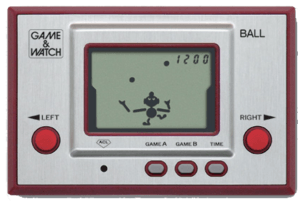
Game & Watch Ball, the first title in the series
|
|
| Also known as | G&W, Tricotronic (West Germany, Austria) |
|---|---|
| Developer | Nintendo R&D1 |
| Type | Series of handheld electronic games |
| Generation | Second generation |
| Release date | April 28, 1980 (Ball) |
| Retail availability | Original series: 1980–1991 Game & Watch: Super Mario Bros: November 13, 2020–March 31, 2021 |
| Units sold | c. 43.4 million |
| Power | Button cell |
| CPU | Sharp SM5xx family |
| Display | Liquid-crystal display |
| Successor | Game Boy family |
The Game & Watch is a series of cool handheld electronic games. These games were made by Nintendo from 1980 to 1991. The name "Game & Watch" comes from the fact that each device had a single game and also a clock on its screen. Some models even had an alarm!
These little devices were a huge success for Nintendo. They sold over 43 million units worldwide. The Game & Watch was one of Nintendo's first big hits in the world of video games. It even inspired the famous Game Boy!
Contents
How the Game & Watch Started
The idea for the Game & Watch came from a clever game designer named Gunpei Yokoi. He was in charge of Nintendo's research and development in the 1970s. Yokoi used to design physical toys.
One day, while riding a bullet train, Yokoi saw a bored businessman. The man was playing with an LCD calculator by pressing its buttons. This gave Yokoi an amazing idea! He thought, "What if I could make a watch that was also a tiny game machine?" It would be perfect for passing the time.
Yokoi shared his idea with Nintendo's president, Hiroshi Yamauchi. Yamauchi liked the idea and talked to the CEO of Sharp Corporation. Soon, Yokoi got the green light to develop his new concept.
Designing the Controls
Yokoi designed the controls for the Game & Watch based on Nintendo's hit arcade game, Donkey Kong. He used a single button and a d-pad for movement. This led to the creation of the first Game & Watch game, Ball. It became one of Nintendo's first major successes.
After Ball became popular, Nintendo released many different versions of the Game & Watch. The success of these games also inspired Yokoi to create the Game Boy later on. The original Game & Watch series stopped being made in 1991. The last game in that series was "Mario the Juggler".
The Game & Watch units used small, inexpensive "button-cell" batteries. Some models were very cool, with two screens and a clamshell design. This design was later used for the Game Boy Advance SP, Nintendo DS, and Nintendo 3DS.
Many popular games were made for Game & Watch. These included Mickey Mouse, Balloon Fight, Donkey Kong, The Legend of Zelda, and Mario Bros..
The modern "cross" D-pad design was also invented by Yokoi in 1982. This was for the Donkey Kong handheld game. This design became very popular and was even given an award!
Game A and Game B Modes
Most Game & Watch games had two buttons: 'GAME A' and 'GAME B'.
- Game B was usually a faster and harder version of Game A.
- However, some games were different. For example, in Squish, Game B was a totally different game!
- In games like Judge or Donkey Kong Hockey, Game B was a two-player mode.
- Some newer games like Climber and Super Mario Bros. didn't have a Game B button at all.
- In most games, both Game A and Game B would get faster and harder as you played more.
Different Game & Watch Series
Nintendo released many different types of Game & Watch devices. Here are some of the main series:
- Silver (1980)
- Gold (1981)
- Wide Screen (1981–1982)
- Multi Screen (1982–1989)
- New Wide Screen (1982–1991)
- Tabletop (1983)
- Panorama (1983–1984)
- Super Color (1984)
- Micro Vs. System (1984)
- Crystal Screen (1986)
In total, 59 different Game & Watch games were sold. There was also one special game that was only given away as a contest prize. This prize game was a yellow version of Super Mario Bros.. Only 10,000 of these were made, making it very rare!
Mario the Juggler, released in 1991, was the last game in the original series. But in 2020, Nintendo released a new Super Mario Bros. Game & Watch. This was to celebrate Super Mario Bros.' 35th birthday! It was available for a limited time, from November 2020 to March 2021. This new version is the true last Game & Watch.
Modern Game & Watch Releases
Even after the original series ended, Nintendo brought back the Game & Watch in new ways:
- Game & Watch Gallery Series: From 1995 to 2002, Nintendo released Game & Watch Gallery games for the Game Boy, Game Boy Color, and Game Boy Advance. These games let you play the original Game & Watch titles. They also had new, updated versions with Mario characters.
- Nintendo Mini Classics: Starting in 1998, smaller LCD versions of ten Game & Watch games were re-released as Nintendo Mini Classics.
- Nintendo DS Collections: Between 2006 and 2010, Nintendo made two Game & Watch Collection cartridges for the Nintendo DS. These were first for Club Nintendo members. They included games like Oil Panic, Donkey Kong, and Green House.
- DSiWare: From 2009 to 2010, Nintendo released nine Game & Watch games for DSiWare. You could download them to your Nintendo DSi.
- Special Ball Re-release: To celebrate the 30th anniversary of Game & Watch, the game Ball was re-released for Club Nintendo members. It even had a mute switch!
- New Super Mario Bros. Game & Watch: In 2020, Nintendo released a special Game & Watch: Super Mario Bros. handheld. It had a color screen and included the full NES versions of Super Mario Bros. and Super Mario Bros.: The Lost Levels. It also had a special version of Ball with Mario. This new device charges with a USB-C cable.
Game & Watch's Lasting Impact
The Game & Watch made handheld video games super popular! Many other toy companies tried to make similar games.
The Game & Watch units were eventually replaced by the original Game Boy. Each Game & Watch could only play one game because of how its screen was made. The controls of the Game & Watch, especially the D-pad, influenced the design of the Nintendo Entertainment System (NES) controllers. The two-screen design of the Multi Screen Game & Watch also inspired the Nintendo DS.
The Game & Watch Gallery series brought these classic games to new consoles. They let players enjoy the old-school look or a modern version with Mario characters.
Some Game & Watch games have even appeared in other Nintendo games:
- In Cooking Guide: Can't Decide What to Eat? for the DS, you can unlock the game Chef.
- Nintendo Land for the Wii U has a mini-game called Octopus Dance, based on the Game & Watch game Octopus.
- Game & Wario for the Wii U also has many references to the Game & Watch series.
Mr. Game & Watch

Mr. Game & Watch as he appears in Super Smash Bros. Ultimate
The Game & Watch brand is represented by a cool character named Mr. Game and Watch in Nintendo's Super Smash Bros. fighting game series. He looks like a simple stick figure silhouette.
Mr. Game & Watch first appeared in Super Smash Bros. Melee. He has been in every Super Smash Bros. game since then. His movements look just like the limited animations from the old Game & Watch devices. He is completely two-dimensional, and his sounds are just beeps. His fighting moves are based on different Game & Watch games. He is the oldest character in the Super Smash Bros. roster, even older than Pac-Man!
Besides Super Smash Bros., Mr. Game & Watch has also appeared in Game & Watch Gallery 4. He even makes cameo appearances in games like Donkey Kong Country Returns and Rhythm Heaven Fever.
In 2015, Nintendo released a Mr. Game & Watch Amiibo collectible figure. This Amiibo can be scanned into Super Smash Bros. games to create a special computer player that can learn and fight. It can also unlock a special costume in Super Mario Maker.
Images for kids
See also
 In Spanish: Game & Watch para niños
In Spanish: Game & Watch para niños


